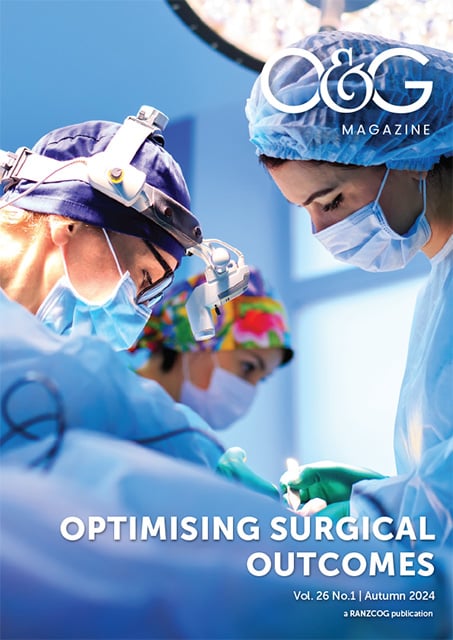It’s dark as you walk into the delivery suite. At 4am it feels like the rest of the world is asleep. Like you should be. And it’s quiet, at least until you get to the room where your patient is. The gut-wrenching screams of a failed epidural.
Your patient is a multi. Second baby. Feeling pushy. But only just fully – with a high head and malposition. The CTG is ugly. Very ugly. And, of course, there is no anaesthetist or theatre staff in the hospital.
Sound familiar? Many obstetricians will recognise the sinking feeling that goes with this situation. The easy normal birth that you were anticipating while coming in is not happening. What to do? Attempt an instrumental delivery in the Birth Suite? – what if I can’t get the baby out? But can I wait for theatre/an anaesthetist? Will a tocolytic help or do I want contractions for a possible instrumental? No one else can help you with these decisions. The labour ward is a lonely place at 4am.
Simply being a doctor means belonging to a potentially lonely profession. In 2018, medicine was deemed as being the loneliest occupation1.
“Surely this can’t be true in O&G?” you might argue. Not in a specialty filled with families, new life and joy? Well, compared with other specialties, Obstetrics also carries enormous expectations of perfect outcomes every time. Perfect babies. Beaming mothers. And what of Gynae? Surely any operation that can be performed through four tiny incisions must be easy – without post-operative pain or risk of complication?
In the not uncommon birth scenario above, the end-result will almost always be favourable in Australia and New Zealand – thanks to a combination of our resource rich systems, excellent clinical training, and input from Mother Nature. Thankfully most of the time the sleep-interrupting and stress-provoking event results in a healthy and happy mother and baby. Does that mean the anxiety (sometimes terror) that you have felt is overblown?
It can certainly feel that way when the experience is shared with a layperson and the response is: “So the baby is okay, right? What’s the big deal?” It can be even more frustrating when a non-obstetrician says: “Why didn’t you just do a Caesar?” when discussing this (or almost any other) intra-partum scenario.
What they often don’t understand is that a major component of the stress associated with these situations is precisely because there is often no obvious or easy solution. What the obstetrician knows is that although the outcomes are almost always good – sometimes they aren’t. The wonderful profession of O&G with overwhelmingly positive results and uplifting experiences is balanced by rare devastating outcomes. It goes with the territory. It is either a very fortunate or a very inexperienced Obstetrician Gynaecologist who hasn’t been involved in at least one awful complication or tragic episode in their career.
The value of support
Early on in my Consultant career, I had a difficult surgical complication which I had never heard of or seen before. I couldn’t sleep and ruminated on the problem. Was it sheer bad luck that had caused this patient to be damaged, or was I in some way incompetent? My compassion for the woman threatened to become unbalanced. To tip from a feeling of guilt that I was responsible for the patient’s suffering, into a sense of shame – that I was somehow defective or inherently flawed.
A few days after the event, I encountered a senior colleague who related that he had been involved with the same complication early in his long career and knew of another similar case. Immediately, I felt a weight lift. I was not the only one who had experienced this situation! I realised that it was not just me. The older colleague was generous, he did not need to share his experience with me – many of us will not admit to ever having had a complication – but by doing so, he eased my worries and taught me a lesson on kindness and leadership.
Many times in my career I have recognised the value of a group-practice tearoom that allowed discussion of clinical difficulties or suboptimal outcomes, and the associated release of tension in sharing these issues. Open discussions normalise some of the pressures we all feel and also facilitate learning. Being able to express vulnerability builds bonds and creates better doctors.
Understanding ourselves
All doctors are high achievers. Many, perhaps most, of us have perfectionistic tendencies. These personality traits may be part of the mix that drives attention to detail and allows provision of excellent care day after day. Together with this, we often suppress our own emotional response to facilitate effective treatment, especially in emergencies.
We need to be decisive and clinical. Yet perfectionism, invulnerability and emotional suppression can have troubling associations with anxiety, burnout, isolation, and poorer health2,3. We must get the balance right with the emotional and psychological mindset that allows best patient care, while also recognising what is required for our own wellbeing.
If our personality characteristics can put us at risk of poorer psychological health, and we operate in a pressurised and potentially isolating field where the only people who can really understand our work demands are our colleagues, it appears vital that we have a system of support and care for each other.
What do we need for wellbeing?
To look after our ourselves, support each other and optimise the resilience of our workforce, we need to first understand what it is we need to promote our own health and wellbeing.
In this setting, Self-Determination Theory (SDT)4 is a sound empirically supported theory of human motivation and wellbeing. According to SDT, the basic needs for optimal functioning and psychological wellbeing are: a sense of autonomy, competence, and relatedness. If any are not satisfied, one’s motivation and wellbeing are impacted.
Consultants tend to enjoy relative autonomy and specialty training usually ensures competence. However, occasionally the relatedness component of wellbeing can be lacking. This is due to many reasons including excessive workload, perceived competitive aspects of the profession, and suboptimal team or organisational culture. In my opinion, relatedness is the element that we must build on. Improved relationships, better bonds, higher functioning teams – these all result in improved individual wellbeing and better organisational outcomes, including patient care.
The importance of healthy work relationships
Feeling connected to peers is critical to our own health. Loneliness at work can lead to significant health risks, with increased all-cause mortality akin to smoking half a packet of cigarettes a day5. Poorer work connections also impact on one’s family and predispose some people to burnout and subsequent increased errors in patient care6,7.
Just as SDT tells us that we need to feel relatedness and connection to enable motivation and wellbeing, Gallup workplace analytics have found that people in all industries who are not able to identify a ‘best friend at work’ have reduced engagement and productivity, make more mistakes, are more likely to leave the workplace, and have higher burnout rates8,9. These effects of friendship, or lack of, have also been found in medical workplaces10. For a doctor, lack of a best friend at work – or even worse, having no friends – reduces wellbeing and translates to poorer clinical outcomes. The benefit of tight bonds with colleagues is highlighted even more starkly when an adverse event occurs in one’s practice.
Some may argue that focusing on improving peer-to-peer relationships within the profession is superficial and unnecessary. However, I think this attitude is outdated. Our world has changed, and the healthcare landscape has new challenges. The burnout epidemic is only one of many reasons why it’s imperative to support all staff and colleagues, including trainees.
Building supportive relationships at work
The creation of better bonds at work has multiple benefits for everyone. For doctors, the benefits include enhanced life-satisfaction and health, and will have flow-on effects outside work. Teams will achieve greater success with clinical outcomes; hence team leaders need to value and prioritise inclusion and relationships.
For institutions, the effects of better relationships include patient satisfaction and improved organisational culture.
This process starts with each of us, and with every interaction. To be supported by friends at work requires us to have previously nourished our relationships with colleagues. Being available, empathetic, and prepared to listen helps enormously. Recognising the worth of others is essential, likewise we must allow ourselves to feel gratitude and affection. Collaboration as teammates with the same goals rather than competition with co-acting agents in the same space is also key.
The role of organisational leaders is crucial in creating a supportive, learning, caring culture. Becoming friends with another person generally involves spending time together and getting to know each other well. Team and departmental initiatives can prioritise opportunities for colleagues to connect more deeply.
Friendship involves curiosity, empathy, and a degree of joint vulnerability. Leaders who value and model these behaviours display authentic leadership. Leaders must be connectors, too – enabling high-quality connections to be fostered between teammates.
We will all go through difficult times, whether clinical or personal, in our careers. But these problems will be navigated more easily with support. When no one else can truly understand the challenges we face, we need to support each other.
Dr Craig is an experienced Obstetrician and Gynaecologist who also provides coaching for doctors and systems optimisation for teams through his company PosMed. He can be reached at: [email protected]
References
- Achor, Rosen-Kellerman, Reece et al. (2018). America’s Loneliest Workers. Harvard Business Review, March 19th.
- Jackson-Koku & Grime. (2019). Emotion regulation and burnout in doctors: A systematic review. Occup Med, 69(1), 9-21.
- Martin, S. R., Fortier, M. A., Heyming, et al. (2022). Perfectionism as a predictor of physician burnout. BMC Health Services Research, 22(1), 1425.
- Ryan, R., & Deci, E. (2000). Self-Determination Theory and the facilitation of intrinsic motivation, social development, and wellbeing. Am Psychologist, 55(1), 68.
- Holt-Lunstad, J., Smith, T. B., Baker, M., Harris, T., & Stephenson, D. (2015). Loneliness and social isolation as risk factors for mortality: a meta-analytic review. Perspectives on psychological science, 10(2), 227-237.
- Shanafelt, T. D., Balch, C. M., Bechamps, G., et al. (2010). Burnout and medical errors among American surgeons. Annals of surgery, 251(6), 995-1000.
- West, C. P., Dyrbye, L. N., & Shanafelt, T. D. (2018). Physician burnout: contributors, consequences and solutions. Journal of internal medicine, 283(6), 516-529.
- Mann, A. (2018). Why we need best friends at work. Gallup.
- Clifton, J., & Harter, J. (2021). Wellbeing at work. Simon and Schuster.
- Doolittle, B. R. (2021). Association of burnout with emotional coping strategies, friendship, and institutional support among internal medicine physicians. Journal of clinical psychology in medical settings, 28(2), 361-367.






Leave a Reply